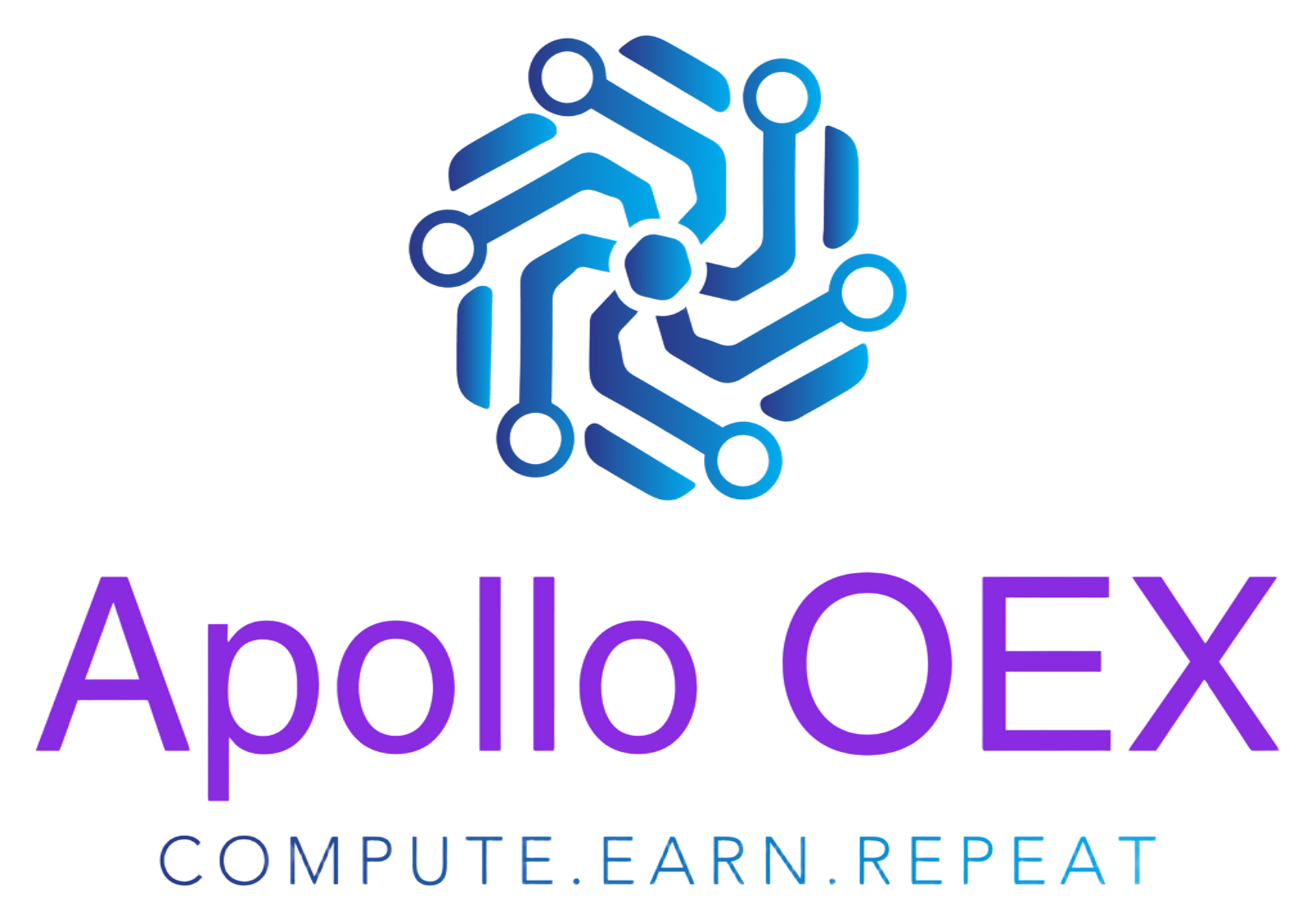Apollo OEX - Yellow Paper
Apollo OEX: Organized Exchange for Computational Resources
1. Introduction
Apollo OEX (Organized Exchange) is a comprehensive blockchain-powered platform designed for the efficient trading of computational resources through an organized exchange mechanism. The platform enables participants to execute trades in both spot and futures markets, incorporating advanced technologies such as AI-driven market mechanisms, blockchain-based settlement, and a sophisticated matching engine.
2. System Architecture
2.1 Core Components
Exchange Engine: Central matching system implementing price-time priority algorithm
Blockchain Integration: Smart contract-based settlement and verification
AI Agent Framework: Intelligence layer for market making and validation
Risk Management System: Circuit breakers and position management
Frontend Interface: React-based trading dashboard and management tools
2.2 Technical Stack
Backend: FastAPI (Python) for API endpoints and business logic
Frontend: React with TypeScript and Tailwind CSS
Database: PostgreSQL with SQLAlchemy ORM
Blockchain: Solidity smart contracts for on-chain operations
Real-time Communication: WebSocket for market data and order updates
Containerization: Docker with Kubernetes orchestration
3. Exchange Engine
3.1 Matching Engine
The matching engine implements a price-time priority algorithm that efficiently pairs buy and sell orders based on price competitiveness and submission time. The engine supports:
Market and limit orders
Order book management with depth visualization
Trade execution with comprehensive logging
Resource-specific order matching rules
3.2 Resource Categorization
Resources are classified into two matching types:
Required-Match Resources: CPU and GPU resources requiring exact specification matching
Flexible-Match Resources: Memory and storage with flexible specification matching
3.3 Resource Specifications
The system handles detailed specifications for computational resources:
CPU: Cores, clock speed, architecture, virtualization support
GPU: Cores, memory, model specifications
Memory: Capacity, type, speed parameters
Storage: Capacity, type, performance metrics (IOPS)
4. Blockchain Integration
4.1 Smart Contracts
The platform utilizes several key smart contracts:
ApolloToken: ERC20 token (AOEX) with governance capabilities
ValidatorIncentives: Manages validator staking and rewards
AIAgentRegistry: Registration and certification of AI agents
ValidationRecords: Immutable record of resource validations
TPMIntegration: Trusted Platform Module integration for hardware validation
4.2 Tokenomics
The AOEX token serves multiple purposes:
Platform governance through voting
Validator staking with rewards
Transaction fee payment
Market making incentives
Settlement currency for trades
4.3 Validation System
The blockchain validation system ensures:
Computational resources meet specifications
Performance claims are verified
Service Level Agreements (SLAs) are enforced
Disputes are resolved through on-chain processes
5. AI Integration
5.1 AI Agent Framework
The AI agent framework provides:
Resource performance prediction
Market price forecasting
Anomaly detection in trading patterns
Automated trading strategies
SLA compliance monitoring
5.2 Agent Identity and Registry
The platform includes a robust system for AI agent identity:
On-chain agent registration
Verification of agent capabilities
Performance tracking and reputation
Reward distribution based on contribution
6. Risk Management
6.1 Circuit Breakers
The risk management system implements circuit breakers to:
Prevent excessive price volatility
Pause trading during abnormal market conditions
Protect market participants from extreme price movements
Enable orderly unwinding of positions
6.2 Position Management
The position management system provides:
Real-time position monitoring
Margin requirement calculation
Liquidation process for under-collateralized positions
Risk profile assessment for users
7. Market Types
7.1 Spot Market
The spot market enables immediate exchange of computational resources with:
Instant settlement on trade execution
Direct resource allocation to buyers
Transparent pricing based on current supply and demand
Market depth visualization
7.2 Futures Market
The futures market facilitates forward contracts for computational resources:
Standardized contracts for future resource delivery
Margin-based trading with leverage capabilities
Daily mark-to-market settlement
Expiration and delivery mechanisms
8. User Roles
8.1 Resource Providers
Entities that supply computational resources to the market:
Cloud service providers
Data centers
Cryptocurrency miners
Individual server owners
8.2 Resource Consumers
Entities that purchase computational resources:
AI/ML researchers
Scientific computing users
Web service providers
Blockchain validators
8.3 Validators
Network participants that verify resource claims:
Stake AOEX tokens to qualify
Perform validation of computational resources
Receive rewards for accurate validations
Maintain network integrity
9. Pricing Mechanism
9.1 Price Discovery
The price discovery system:
Aggregates market orders to determine fair price
Incorporates external price references
Applies AI-driven forecasting models
Accounts for resource specifications and quality
9.2 Market Data Distribution
Market data is distributed through:
Real-time WebSocket feeds
REST API endpoints for historical data
Aggregated market summaries
Price index calculations for resource categories
10. Security Model
10.1 Authentication and Authorization
JWT-based authentication
Role-based access control
Multi-factor authentication
API key management for programmatic access
10.2 Trade Security
Secure order validation process
Transaction signing for order authenticity
Rate limiting to prevent abuse
Order audit trails for compliance
11. Deployment Architecture
11.1 Containerization
Docker containers for all services
Multi-stage builds for efficiency
Health checks and graceful shutdown
Security hardening configurations
11.2 Orchestration
Kubernetes deployment for production
Service discovery and load balancing
Auto-scaling based on demand metrics
Resource quota management
12. Monitoring and Analytics
12.1 System Monitoring
Prometheus metrics collection
Grafana dashboards for visualization
Alerting for critical events
Performance benchmarking
12.2 Market Analytics
Trading volume analytics
Price trend analysis
Market depth visualization
User behavior insights
13. Conclusion
Apollo OEX represents a significant advancement in the trading of computational resources. By combining traditional exchange mechanisms with blockchain technology and AI-driven processes, the platform creates an efficient, transparent, and secure marketplace. The comprehensive architecture enables both spot and futures trading of standardized computational resources, opening new opportunities for resource optimization in the global computing ecosystem.
List of Services
-
About Us Write a description for this list item and include information that will interest site visitors. For example, you may want to describe a team member's experience, what makes a product special, or a unique service that you offer.Item Link List Item 1
-
Roadmap Write a description for this list item and include information that will interest site visitors. For example, you may want to describe a team member's experience, what makes a product special, or a unique service that you offer.Item Link List Item 2
-
Yellow Paper Write a description for this list item and include information that will interest site visitors. For example, you may want to describe a team member's experience, what makes a product special, or a unique service that you offer.Item Link List Item 3

